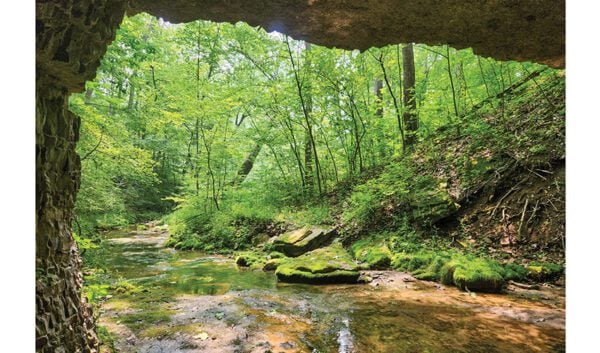Indiana Landmarks Black Heritage Preservation Program partnered with The Nature Conservancy (TNC) to map Black history sites across Indiana.
The program plans to unveil an interactive map telling the history of more than 60 African American settlements from the early 1800s until the start of the Civil War.
The Indiana Landmarks Black Heritage Preservation Program aims to help tell the stories of Black history and where it happened, even with minimal physical evidence. Established in 1992, the program is funded by a $5 million grant from Lilly Endowment Inc., private donors and the National Trust for Historic Preservation’s African American Cultural Heritage Action Fund.

TNC protects and conserves natural habitats across the state. Through their partnership, the program will research sites with potential connections to Black history within some of the nature preserves.
The project began at Boone’s Cave in Owen County, located within Green Bluff’s Nature Preserve. The cave was rumored to house kidnapped African Americans before they were sold into slavery or used as a hideout along the Underground Railroad.
Researchers found through property records and interviewing local historians that the cave was most likely used as a hideout for freedom seekers. The land is on a lot once owned by former slave Zilpha Boon, who is buried in a cemetery near the preserve.
Following the exploration of the cave, the project will research nature preserves statewide. TNC funded the Black Heritage Preservation Project’s work and contributed independent research to the cause. Their support provided interns, covered costs of the documentary and contributed information collected from their own mapping and historical initiatives.
“For us, the conversation has been very exciting,” said Melissa Moran, director of community programs for TNC’s Indiana chapter. “Now where we’re looking at properties where we’ve been made aware of their proximity to historic Black settlements, we’re able to open up conversations with partners we may not have reached out to previously.”

The interactive map will include the location of Black settlements, a brief history of each site and resources for further research like census records and historic photographs.
“We hope this map will broaden awareness of early Black history in the state and spur further research,” said Eunice Trotter, director of Indiana Landmarks Black Heritage Preservation Program.
The Indiana Landmarks Black Heritage Preservation Programs offers grants ranging from $500 to $40,000 for restoration and preservation of Black heritage sites in Indiana, and $250 to $10,000 for interpretive documenting projects to bring the public’s attention to Black history no longer evidence by physical sites.
A short film on Boone’s Cave and the exploration and research is set for an upcoming premiere. Visit indianalandmarks.org to learn more or apply for a grant.
To read more like this, click here.
Contact Health & Environmental Reporter Hanna Rauworth at 317-762-7854 or follow her on Instagram at @hanna.rauworth.
Hanna Rauworth is the Health & Environmental Reporter for the Indianapolis Recorder Newspaper, where she covers topics at the intersection of public health, environmental issues, and community impact. With a commitment to storytelling that informs and empowers, she strives to highlight the challenges and solutions shaping the well-being of Indianapolis residents.








Thank you so much for sharing this wonderful post with us.
A great post without any doubt.